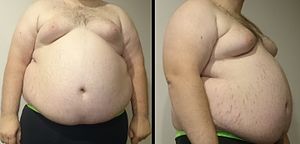 Image via WikipediaNo, This Is Why You're Fat! : TreeHugger
Image via WikipediaNo, This Is Why You're Fat! : TreeHugger
PCRM
In a classic case of contradictory government policy the above pyramids clearly show the inverse relationship between federal government agriculture subsidies and federal nutrition recommendations. Originally published in 2007 by Physicians Committee for Responsible Medicine (PCRM) in Good Medicine Magazine to outline the committee's concern about the impending farm bill. The graphic recently resurfaced in food security circles and found its way to the Economix Blog @ The New York Times.
Click through for why this is important and some more nifty graphs that help explain the obesity epidemic.
The original PCRM article explains the regulatory discrepancy that results in an obese nation.
The Farm Bill...governs what children are fed in schools and what food assistance programs can distribute to recipients. The bill provides billions of dollars in subsidies, much of which goes to huge agribusinesses producing feed crops, such as corn and soy, which are then fed to animals. By funding these crops, the government supports the production of meat and dairy products--the same products that contribute to our growing rates of obesity and chronic disease. Fruit and vegetable farmers, on the other hand, receive less than 1 percent of government subsidies.(Despite an early pledge to cut big ag subsidies Obama caved to the power of the industry and reversed this plan.)
The government also purchases surplus foods like cheese, milk, pork, and beef for distribution to food assistance programs--including school lunches. The government is not required to purchase nutritious foods.
A quick look through Economix came up with a couple more telling charts. This first one shows "the relationship between time the average person in a given country spends eating and that country's obesity rate." (Lloyd told us about this chart last year.)

Catherine Rampell @ Economix
And then there's this one, that shows how the price of fruits and vegetables has increased over the past 30 years while everything else, including meat, beer, and especially soda has decreased.

David Leonhardt @ Economix
Leonhardt goes on to say:
...the average 18-year-old today is 15 pounds heavier than the average 18 year-old in the late 1970s. Adults have put on even more weight during that period. The average woman in her 60s is 20 pounds heavier than the average 60-something woman in the late 1970s. The average man in his 60s is 25 pounds heavier. When you look at the chart, you start to understand why.Now, imagine what those charts would look like if mixed fruit and vegetable farms were subsidized at the same rates as meat and dairy operations.


No comments:
Post a Comment